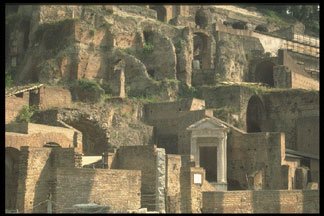The City of Rome
The city of Rome developed from a small group of villages on
seven hilltops.The valleys between the hills were marshy until Roman engineers
figured out how to drain the water. The city grew from humble beginnings to
become the largest city in the ancient world. At its peak, the population is
estimated to have reached one million people. With this large population, the
Romans needed a very large importation of food from around the empire, especially
wheat from Egypt.
hilltops.The valleys between the hills were marshy until Roman engineers
figured out how to drain the water. The city grew from humble beginnings to
become the largest city in the ancient world. At its peak, the population is
estimated to have reached one million people. With this large population, the
Romans needed a very large importation of food from around the empire, especially
wheat from Egypt.
The city, which grew organically (meaning unplanned), did not have streets wide enough to accommodate the large amount of traffic. Starting in the time of Julius Caesar, wagons were banned during daylight hours. Considering the amount of food and items needed in such a large city, the noise from the carts on the cobblestone streets at night was considerable. After the large fire of A.D. 64 , which destroyed over half the city, Emperor Nero organized the streets into blocks with parallel street layouts. Click here to see map (fast internet connection recommended).
During the time of Augustus, a police force consisting of around forty-five hundred policemen was set up to enforce the law during the day. These men were known as urban cohorts, named after the military set up of the army. At night, another seven thousand men were employed as a police and fire brigade. Night patrols were known as the vigils. They played the role of firemen, security teams, and traffic cops during in the night hours.
City of Rome | Circus Maximus | Roman Coliseum | Coliseum #2 | Entertainment at Coliseum
Enterainment in Rome | Roman Forum | Roman Theaters

